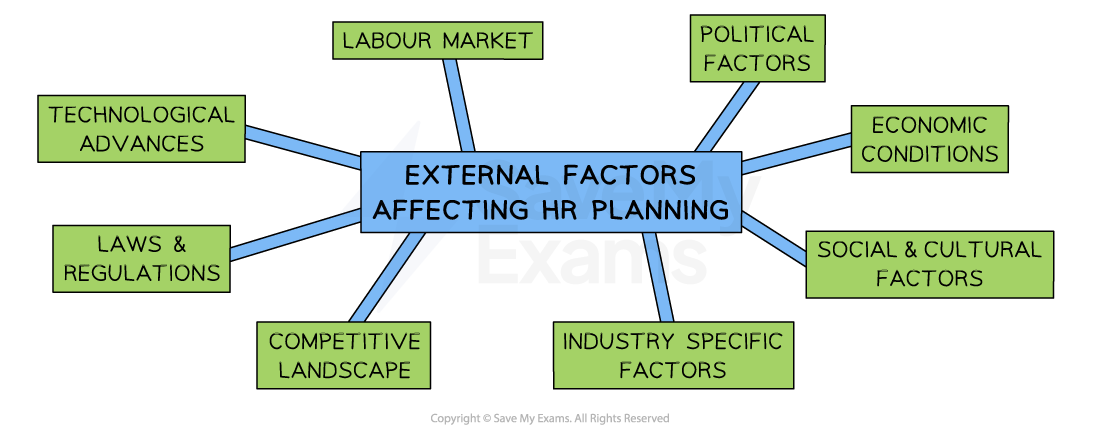- A range of factors beyond the control of a business can also impact the human resources planning process

External factors that affect human resources planning
Economic conditions
- The state of the economy, including factors such as economic growth, inflation, and unemployment rates
- During periods of economic growth a business may need to focus on attracting and retaining staff to meet increased demand
- During economic downturns they may need to implement cost-cutting measures such as redundancies or hiring freezes
Labour market
- The supply of suitable employees and the impact of factors such as skills shortages, labour mobility and immigration
- Spain recently changed its migration laws to recruit more foreigners from overseas for industries with labour shortages and its primary focus for 2023 is to hire carpenters, plumbers, electricians and other workers involved in construction
Technological advancements
- Rapid technological change can disrupt industries and job roles, affecting HR planning
- Automation, artificial intelligence (AI), and other emerging technologies can lead to changes in job requirements, skills needed and workforce composition
- HR planning must anticipate these shifts and consider re-skilling or up-skilling to meet future workforce needs
Legal and regulatory environment
- Laws and regulations related to employment, labour relations, health and safety, immigration
- In 2021 changes to employment law in Greece provided workers with the right to flexibility to the eight-hour working day where employees are allowed to work up to 10 hours on one day and fewer on another or take time off as well as the right to not have to respond to emails after hours
Social and cultural factors
- Social and cultural factors such as societal values and demographic trends
- Workforce diversity and inclusion, flexible work arrangements, work-life balance and employee wellbeing are examples of areas where social and cultural factors are external factors that influence workforce planning
- French laws recognise the custom for a long lunch break and provides for five weeks paid time off for employees as well as protecting the a limit of a 35 hour working week - companies can’t force employees to work overtime and if they do they’re well-compensated for it
Political factors
- Changes in government policies, political stability and geopolitical factors
- Shifts in labour laws, changing tax regulations and immigration policies and cross-border trade agreements are often political focuses which can impact human resources planning
- Australia is currently experiencing a national skills shortage in a number of occupations and its governments plan to fill this gap with a combination of training local Australians and recruiting immigrants - current in-demand skills include construction, civil engineering and nursing
Industry-specific factors
- Different industries may face unique external factors
- Healthcare organisations need to consider factors such as changing regulations, demographic shifts, and advancements in medical technology
Competitive landscape
- The environment in which a business competes for labour and the actions and strategies of competitors influence workforce planning
- HR planning should consider the organisation's position in the market and align recruitment strategies so that the pay and benefits reflect that
- In the UK businesses recruiting hospitality, health and social care workers and professional services staff and are starting to seek talent outside traditional sources by focusing on candidates’ skills and potential rather than qualifications and industry experience to widen the pool of candidates
 How effective human resource management can provide a competitive advantage
How effective human resource management can provide a competitive advantage
 How effective human resource management can provide a competitive advantage
How effective human resource management can provide a competitive advantage